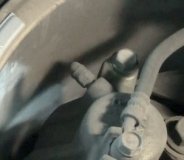W/ Four Wheel Antilock Brakes
ABS system bleeding requires conventional bleeding methods plus use of the DRB scan tool. The procedure involves performing a base brake bleeding, followed by use of the scan tool to cycle and bleed the HCU pump and solenoids. A second base brake bleeding procedure is then required to remove any air remaining in the system.
Perform base brake bleeding.
Connect scan tool to the Data Link Connector.
Select ANTILOCK BRAKES, followed by MISCELLANEOUS, then BLEED BRAKES. Follow the instructions displayed. When scan tool displays TEST COMPLETE, disconnect scan tool and proceed.
Perform base brake bleeding a second time.
Top off master cylinder fluid level and verify proper brake operation before moving vehicle
W/ Rear Wheel Antilock Brakes
Use Mopar brake fluid, or an equivalent quality fluid meeting SAE J1703-F and DOT 3 standards only. Use fresh, clean fluid from a sealed container at all times.
Do not pump the brake pedal at any time while bleeding. Air in the system will be compressed into small bubbles that are distributed throughout the hydraulic system. This will make additional bleeding operations necessary.
Do not allow the master cylinder to run out of fluid during bleed operations. An empty cylinder will allow additional air to be drawn into the system. Check the cylinder fluid level frequently and add fluid as needed.
Bleed only one brake component at a time in the following sequence:
Master Cylinder
Combination Valve
Rear Antilock Valve
Left Rear Wheel
Right Rear Wheel
Right Front Wheel
Left Front Wheel
MANUAL BLEEDING
Remove reservoir filler caps and fill reservoir.
If calipers, or wheel cylinders were overhauled, open all caliper and wheel cylinder bleed screws. Then close each bleed screw as fluid starts to drip from it. Top off master cylinder reservoir once more before proceeding.
Bleed Hose Setup
Attach one end of bleed hose to bleed screw and insert opposite end in glass container partially filled with brake fluid. Be sure end of bleed hose is immersed in fluid.
Open up bleeder, then have a helper press down the brake pedal. Once the pedal is down close the bleeder. Repeat bleeding until fluid stream is clear and free of bubbles. Then move to the next wheel.
PRESSURE BLEEDING
Follow the manufacturers instructions carefully when using pressure equipment. Do not exceed the tank manufacturers pressure recommendations. Generally, a tank pressure of 15-20 psi is sufficient for bleeding.
Fill the bleeder tank with recommended fluid and purge air from the tank lines before bleeding.
Do not pressure bleed without a proper master cylinder adapter. The wrong adapter can lead to leakage, or drawing air back into the system. Use the adapter provided with the equipment or Adapter 6921.
Sunday, October 10th, 2010 AT 9:09 PM


